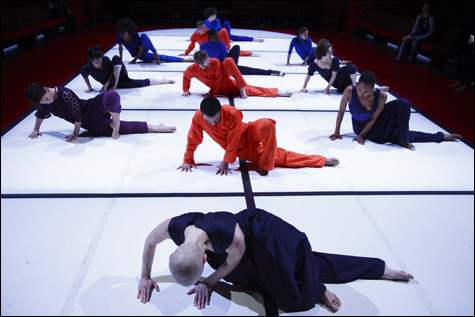
CHAPEL/CHAPTER: This Bill T. Jones work beguiles and distracts and doesn’t give you any easy
handholds on morality. |
Bill T. Jones has always loved double meanings. Chapel/Chapter, his hour-long work about crime and redemption, splices three harrowing life tales into a theatrical environment that beguiles and distracts and makes claims on your energies and doesn’t give you any easy handholds on morality. Attended by buzz, the 2006 dance-theater piece played the Institute for Contemporary Art last weekend, and it will run for two weeks this summer at Jacob’s Pillow (June 26–July 6). Conceived and directed by Jones, Chapel/Chapter is beautifully crafted by a long list of collaborators in the expansive multimedia style of postmodernism that he’s used so effectively in his earlier works.
When we walked into the ICA theater, quiet meditative music was playing. Designer Bjorn Amelan had draped the walls with red curtains, softening and warming the theater’s chic industrial surfaces. Dancers were standing on a luminous white floor that was marked off with black tape into eight squares and surrounded on three sides with a double row of benches. Patrons were being ushered into the close-up seats. Even though it was 15 minutes to curtain time, the audience chatter shrank to a whisper. It was like entering a very dignified, tasteful funeral home or a European concert salon.

The nine dancers slowly, sightlessly begin to walk through the space. People posted around the edges steer them gently so they can’t wander off the grid. Then the movers and the guides leave. Two men come back and one of them starts telling a story about how he broke into a house and killed a family. A woman sitting on one of six red-painted wooden chairs answers his halting account with a sing-song “All right.” The other man rolls away in a blue light, followed by the projected image of a tiny red chair.
The lights change again and a hopscotch diagram appears on the floor. A child’s voice is heard singing a folk song in a language that isn’t English. The two-man band (Christopher Antonio William Lancaster, cello, and Lawrence “Lipbone” Redding, guitar and voice) launch into some jivy music and the rest of the dancers prance back in.
This happened in the first five minutes.
After that, two more stories were added into the mix, all intercut and amplified by projected spoken and sung texts, multi-ethnic flavored music (by Daniel Bernard Roumain), and vigorous input from the dancers. The serial-killer story gets told many times in different ways, sometimes with people dancing out the crime in suggestive but not pantomimic movement. In one long passage, the killer opens up to a woman who prompts him and responds “All right” when he pauses in his grisly narrative. She might be a detective gathering evidence, or a psychiatrist, or a priest. She doesn’t pass judgment.
In another story, a man tries to explain why he killed a troubled daughter whose obstreperous behavior turned pathological. Another man dredges up a childhood incident. As the pieces of his story accumulate, I first think it’s going to be a classic abuse scenario — he’s coaxed into the woods by another boy while at summer camp — but eventually we learn he’s been conscripted into witnessing a suicide.
The words of the stories come back at us again and again — spelled out, chanted, projected as manuscript pages. Enhanced and drilled in, they grow weaker, distant, instead of more affecting.
All the characters seem to be played by more than one performer, and all the dancers take more than one role as well as constituting an anonymous chorus. The three stories overlap. The suicide rolls toward the waterfall; the murder victims do the same movement. The dog howls after the murder; eventually everyone howls in chorus. The interrogator’s accepting but noncommittal “All right” is absorbed into a concluding prayer. “Thy kingdom come . . . this is the way the world begins . . . All right.”
Chapel/Chapter is a piece about reflection. Events that have happened in the past refract into present lives, splay back into memories, fuse into new images and sounds. The music could be Hispanic or Arabic or mediæval plainsong, the room a dance club or a synagogue.
The stories at the heart of Chapel/Chapter are the kind of thing we hear every day in the tabloids and dismiss. Maybe Jones is suggesting we shouldn’t dismiss a gratuitous killer, or blame a parent who can’t cope for offing his troublesome kid. Maybe he wants to include them all in a global act of conscience and forgiveness.
How do we feel about suicide? About a parent’s responsibility for a child gone bad? About salvation? If Jones poses these questions, he offers no answers. There is no good or evil, no blame any one individual can take on, no sign or song that gives absolution to any group. Jones’s consolation seems to lie in the dream of universality and the relinquishing of absolutes. You have only to believe.